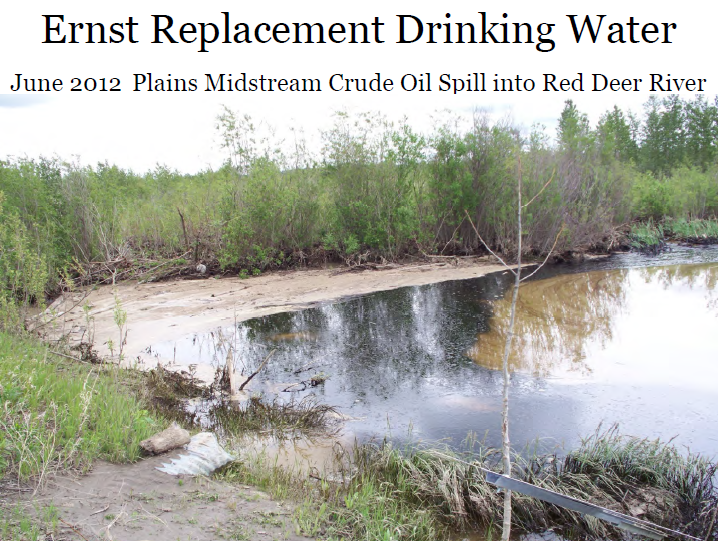OIL ON THE WATER Sask. oil spill has many wondering if a similar disaster could strike Alberta by Dave Mabell, August 20, 2016, Lethbridge Herald
Could that happen here? Do we have an emergency plan? [Does Canada have any plan anywhere, except to give multinational corporations what ever they want (media control and more and more deregulation by our corrupt, cowardly federal and provincial politicians and regulators)?]
Those questions are being asked by many Albertans, responding to this summer’s environmental disaster in Saskatchewan. A Husky oil pipeline ruptured last month, gushing about 250,000 litres of crude oil [and toxic chemical additives] into the North Saskatchewan River.
Prince Albert and North Battleford rely on the river as the source of their water supply, so the spill forced both their water treatment plants to suspend service to residents and businesses indefinitely. City officials scrambled to find alternate supplies, with Prince Albert relying on temporary 30-km pipelineto another river.
Swimming pools, laundromats and car washes were closed, and any resident caught watering the lawn could be slapped with a $1,400 fine.
How about us? What would Lethbridge do if a pipeline dumped 250,000 litres of oil into the Oldman River?
That’s not a danger here, fortunately. While a number of natural gas pipelines cross the Oldman and its tributaries upstream, a search of the Alberta Energy Regulator’s website shows no oil lines to pose a danger.
But other communities in Alberta – with an estimated 431,000 km of pipelines carrying oil, gas or related products – may not be as fortunate. The [legally immune, Charter and other law violating, industry protector, pollution cover-upper extraordinaire] energy regulator would play a first responder role in any such disaster.
In Lethbridge, nevertheless, a tanker truck servicing oilwells west of the city could cause at least a short-term emergency if it turned over on a bridge. So could a tanker car on the railway.
Doug Kaupp, manager of the city’s water and waste water services, says the city’s emergency response plans cover such possibilities as river contamination. Reservoirs in various parts of the city can provide a short-term supply, as they did during a period of high river turbidity recently.
“We’ve never experienced anything the like of what’s happened in Saskatchewan,” he says.
The city also supplies potable water to Coaldale, Coalhurst and as far north as Iron Springs, he points out. If an emergency forced Lethbridge residents to severely curtail their use, it would affect those communities as well. The McCain potato plant, at one end of the line, would also be rationed.
Kaupp says unlike Prince Albert, this city doesn’t have another large river nearby to act as a back-up. The St. Mary River joins the Oldman just south of the city, but it would be difficult if not impossible to pump any of its water to the treatment plant.
In the light of the North Saskatchewan River’s long-term contamination, Kaupp says he wants to work with Lethbridge’s emergency services co-ordinator – Fire Chief Richard Hildebrand – to formulate a more detailed response to water supply disasters. [WHERE’S WHEATLAND COUNTY’S RESPONSE TO ROSEBUD’S FRAC’D AND CONTAMINATED DRINKING WATER DISASTER, COURTESY OF GWYN MORGAN AND ENCANA? NOWHERE TO BE SEEN. RESIDENTS AND TENS OF THOUSANDS OF TOURISTS CONTINUE TO BE EXPOSED TO EXPLOSIVE CONCENTRATIONS OF METHANE AND ETHANE CONTAMINATION AND AS OF YET UNDISCLOSED CHEMICALS ENCANA INJECTED INTO THE AQUIFERS, WITH ALBERTA GOVERNMENT AND REGULATOR BLESSINGS.]
“It would be prudent for us to dust off our plans and see what could be done.”
Meanwhile in Prince Albert, the local state of emergency has ended and some of the residential use restrictions have been lifted. The spray parks and paddling pools have reopened, and parched lawns in city parks have been irrigated.
But the city is still relying on a series of over-land pipes, stretching 30 km to the South Saskatchewan River, while health officials continue to test the North Saskatchewan.
It’s been more than a month since their own river was contaminated – and residents are not looking forward to a frosty fall. [Emphasis added]
[Refer also to:

Slide from Ernst presentations [Ernst continues hauling water from this source, as of August 21, 2016]
Plains Midstream Canada will “make it right” with effected residents ]
